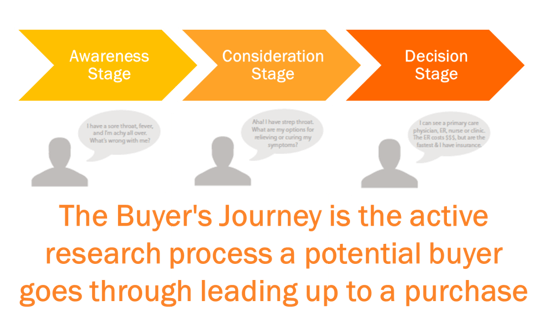To survive in the digital world, we are all part of, office product resellers must take steps to enter it, and the longer this is put off, the more urgent it becomes. Digital transformation is not an "opt-out" program for resellers. We know the ongoing switch from analog is not going away and that resellers, who elect to stay in the analog world, are (sooner or later) destined to fail.
Quick recap!
These days it's pretty easy to deploy an e-commerce site with a full complement of office products. It's pretty easy to integrate the technology to link these products to suppliers and set it up for online transactions.
The problem is that because it's relatively easy to get all this done, this is what has been done, and it's what has, unfortunately, failed many times! These actions have proven inadequate as a foundation for a digital business transformation.
Why does this strategy fail?
Because this effort has all been geared toward the final (decision) stage of the buying process and lacks the other elements necessary for a successful digital strategy, it's turned out to be of little value.
As we all know, it has become the norm for anyone interested in buying anything to research online first. This buyer research transmits intent that correlates to the different stages of the buyer's journey.
 The fundamental mistake typical office product resellers make is the failure to create content targeted at the awareness and consideration stages of the buying process. These critical stages must be leveraged to qualify a business in readiness for future buying decisions.
The fundamental mistake typical office product resellers make is the failure to create content targeted at the awareness and consideration stages of the buying process. These critical stages must be leveraged to qualify a business in readiness for future buying decisions.
The following two requirements are vital to establishing the foundation for a digital business transformation:
- Developing brand awareness through the process of leveraging high-quality content designed to build web traffic and;
- Thereby qualifying a business as a potential supplier when the buyer reaches their decision point.
It's really simple, if content for the first two stages is not deployed, there is no foundation to qualify a business for a transaction when a buyer is ready to buy.
It used to be the physical, brick-and-mortar store that qualified a business for potential buyer transactions. As a buyer prepared to buy, the buyer went shopping. There was no online option - they went shopping. A poorly maintained or positioned store was (and remains) less likely to transact than a well-placed, well-maintained store. Store owners were heavily incentivized to make the most of their real estate.
What has changed?
Very little! The only part of the buying process that has substantially changed is:
- The buyer's access to information and;
- Fewer buyers leave their houses or offices to shop.
Unfortunately, though, these two changes have profound implications.
Instead of investing in brick-and-mortar and stocking a physical store to run a business, investing and establishing an online presence has become necessary.
It used only to be the most prominent players who could afford the highest rents in the prime locations and best positioned themselves to benefit from the most increased foot traffic. Today, however, it's much more of a level playing field. The vast majority of potential buyers and sellers have access to the Internet, and it doesn't cost more for the smallest of companies to "rent" some space on the IInternet than it does for the largest companies.
As a result, the barriers to establishing an essential website are low, and there are now nearly one billion sites proliferating the Internet. The issue for business owners has become one of developing site awareness. Unfortunately, there's almost zero chance of having qualified traffic organically arriving and ready to transact without them doing so.
It used to be, as buyers, our choice was limited to what was stocked in the local stores we chose to drive to. This gradually changed as, (for example) in its day, the Sears catalog became a massive success because it expanded its product offering and increased consumer choice. The Internet has now taken this process to an entirely new level, evolving to provide almost unlimited information and unlimited option.
The problem has always been to stand out from the crowd, and a prime location on the High Street used to help accomplish this. Now, the real estate environment has changed, and it's no longer the High Street and no longer about being able to afford the highest rent. It's about the Internet and developing awareness for a website and its brand within this new "digital" real estate platform.
This is where every digital transformation must start - with a website and the realization that it alone is not enough to separate anyone from the crowd. Without a comprehensive strategy to develop relevant, qualified traffic, it may not exist.
Conclusion:
The foundation for a digital transformation must be the company's website and the value proposition that it must communicate. There are technical, content, and automation standards necessary to accomplish these requirements that, based on hundreds of evaluations, appear to be beyond the current understanding or resources of most independent office product resellers.
Without a strong foundation (website) to build a digital business transformation strategy, attempts to transform will fail. Ask yourself:
- How well does my website perform today?
- Shouldn't I test it to learn how strong my existing digital foundation is?
